 South gate of the fortress | |
 | |
| Location | Lappeenranta, Finland |
|---|---|
Lappeenranta Fortress (Finnish: Lappeenrannan linnoitus) is a fortress located in Lappeenranta, Finland.
 South gate of the fortress | |
 | |
| Location | Lappeenranta, Finland |
|---|---|
Lappeenranta Fortress (Finnish: Lappeenrannan linnoitus) is a fortress located in Lappeenranta, Finland.
In 1649, after a visit to Vipuri, the Governor-General of Finland, Per Brahe the Younger, decided to establish a new town near the waterways. The land use plan was compiled in 1649 by Erik Nilsson Aspgren. [1]
On September 20, 1652, the Diet of Stockholm decided to grant special rights to Lappeenranta. In early 1653, Erik Nilsson Aspgren handed over special rights to the governor Johann Rosenhan.
After the Treaty of Nystad, in the fall of 1721, Sweden established a border commission headed by Axel Löwen, general and state counsellor. In 1722, Axel Löwen established a small garrison to ensure the crossing of the border and the return of refugees. Axel Löwen, Johann Henrik Friesenheim and Brent-Olof Stockenberg then decided to strengthen Lappeenranta. To secure the Lappeenranta bitumen trade, pits and chevaux de frise were set up and 112 soldiers were sent to protect the trading post. In 1723, the brothers Carl Friedrich and Anders Johann Nordenberg were chosen to design the castle along with Jacob Johann Faber. Most of the construction work was done between 1722 and 1728. [2]
When the Hat Party came to power in the late 1730s, it allocated additional funds to expand the fortifications, led by Adam Reinhardt Bruno. However, the fortification work was stopped by the Russo-Swedish War of 1741–1743. [3]
At the beginning of Russian rule, the border guard regiments were often changed. The Lappeenranta fortifications were rebuilt in the 1750s. In the 1790s, the castle came under the command of Alexander Suvorov, who continued to develop it as part of the fortification system of southeastern Finland. During the Russo-Swedish War, the Saimaa fleet became the third garrison of Lappeenranta.
In 1785, during the Russian period, the Orthodox Church of Lappeenranta was also built, making it the oldest Orthodox church of Finland. [4]
After the Finnish Civil War, the White Guards (Finland) established the Lappeenranta prison camp at the castle, which was notorious for the arbitrary executions that took place there. This camp had nearly 3000 Red Guard prisoners, about 500 of whom were executed. [5]

Suomenlinna, or Sveaborg, is an inhabited sea fortress composed of eight islands, of which six have been fortified; it is about 4 km southeast of the city center of Helsinki, the capital of Finland. Suomenlinna is popular with tourists and locals, who enjoy it as a picturesque picnic site. Originally named Sveaborg, or Viapori as referred to by Finnish-speaking Finns, it was renamed in Finnish to Suomenlinna in 1918 for patriotic and nationalistic reasons, though it is still known by its original name in Sweden and by Swedish-speaking Finns.

Imatra is a town and municipality in southeastern Finland. Imatra is dominated by Lake Saimaa, the Vuoksi River and the border with Russia. On the other side of the border, seven kilometres (4.3 mi) away from the centre of Imatra, lies the Russian town of Svetogorsk. The city of St. Petersburg is situated 210 km (130 mi) to the southeast, Finland's capital Helsinki is 230 km (140 mi) away and Lappeenranta, the nearest Finnish town, is 37 km (23 mi) away. Imatra belongs to the administrative province of Southern Finland and the region of South Karelia.

Lappeenranta is a city and municipality in the region of South Karelia, about 30 kilometres from the Russian border and 64 kilometres (40 mi) from the town of Vyborg (Viipuri). It is situated on the shore of the Lake Saimaa in southeastern Finland, and is one of the most significant urban centers in the whole Saimaa region, along with the towns of Imatra, Mikkeli and Savonlinna. With approximately 73,000 inhabitants Lappeenranta is the 13th largest city in Finland, after incorporating the previous municipalities of Lappee and Lauritsala in 1967, Nuijamaa in 1989, Joutseno in 2009, and Ylämaa in 2010.

Hamina is a town and a municipality of Finland. It is located approximately 145 km (90 mi) east of the country's capital Helsinki, in the Kymenlaakso region, and formerly the province of Southern Finland. The municipality's population is 19,558 and covers an area of 1,155.14 square kilometres (446.00 sq mi), of which 545.66 km2 (210.68 sq mi) is water. The population density is 32.09 inhabitants per square kilometre (83.1/sq mi). The population of the central town is approximately 10,000. The municipal language of Hamina is Finnish.
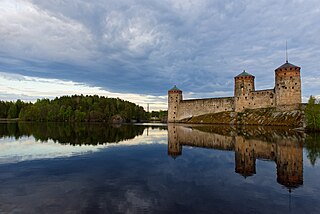
Olavinlinna is a 15th-century three-tower castle located in Savonlinna, Finland. It is built on an island in the Kyrönsalmi strait that connects the lakes Haukivesi and Pihlajavesi. It is the northernmost medieval stone fortress still standing. The castle forms a spectacular stage for the Savonlinna Opera Festival, which was held for the first time in the summer of 1912.

The Russo-Swedish War of 1495–1497, known in Sweden as the Stures' Russian War, was a border war which occurred between the Grand Duchy of Moscow and the Kingdom of Sweden. Although the war was relatively short, and did not lead to any territorial changes, it has significance as the first war between Sweden and Moscow. Sweden earlier fought wars against the Novgorod Republic, before Novgorod was formally annexed to Moscow in 1478.

Vyborg Castle is a fortress in Vyborg, Russia. It was built by the Swedes during the Middle Ages around which the town of Vyborg evolved. The castle became the stronghold of the Swedish realm in the Karelian region. Throughout the centuries, it was the first defence of the kingdom against the Russians. Its military and strategic status in the late Middle Ages was second only to the fortified capital Stockholm. Currently it serves as the site of Vyborg Regional Museum.
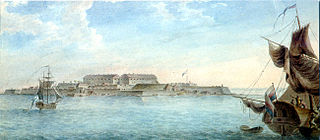
The Svartholm fortress was built between 1749 and 1764 outside Loviisa in Southern Finland by Augustin Ehrensvärd. The fortress, which lies at the mouth of the Bay of Loviisa, along with the planned land fortress at Loviisa, would have prevented invading Russian forces from entering what was then Swedish territory in present-day Finland.

The Finnish National Defence University is a military university located in Helsinki. The university trains officers for the Finnish Defence Forces and the Finnish Border Guard. The main campus is located in Santahamina, Helsinki.

Kyminlinna is a fortress located in the northern part of island of Hovinsaari in Kotka, on the south coast of Finland. Kyminlinna is part of the South-Eastern Finland fortification system built by Russia after the Russo-Swedish War of 1788-1790. Kyminlinna formed the northern part of a double fortification, together with Ruotsinsalmi sea fortress, where Kyminlinna was intended to repulse land-based attacks along the King's Road.
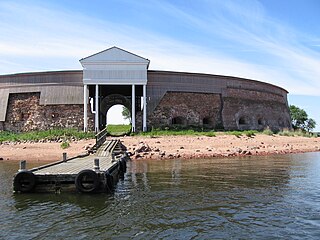
Ruotsinsalmi sea fortress is a fortification system in Kotka, Finland. It is part of the South-Eastern Finland fortification system built by Russia after Russo-Swedish War of 1788-1790. Ruotsinsalmi sea fortress formed the southern part of a double fortress together with Kyminlinna and it was built to counter the Swedish sea fortresses of Svartholm in Loviisa and Sveaborg (Suomenlinna) in Helsinki. Ruotsinsalmi also acted as an outpost of the Kronstadt sea fortress in Saint Petersburg. During the Crimean War, a British-French fleet destroyed the Ruotsinsalmi fortifications in 1855.

South-Eastern Finland fortification system is an extensive defensive system formed by three concentric fortress chains in South-East Finland built by Russia in the 1790s. The purpose of the fortification system was to protect the capital of the Russian Empire, Saint Petersburg, from a possible Swedish attack.

Hamina Fortress is located in Finland on the coast of the Gulf of Finland and it is an integral part of the Hamina city centre. Hamina fortress is a Star fort, representing the Renaissance ideal city embodied by Palmanova city in northeastern Italy.
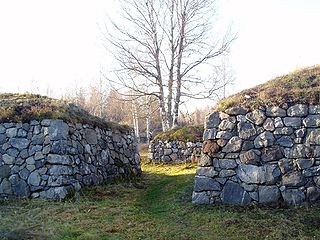
Kärnäkoski Fortress is a bastion fortress in Finland located in Kärnäkoski, Savitaipale built by Russia between 1791 and 1793 to protect Saint Petersburg.

Suvorov military canals is a series of four open canals on Saimaa lake in Finland. The four canals of Kutvele, Käyhkää, Kukonharju and Telataipale are located in Puumala, Ruokolahti and Sulkava. They were built between 1791 and 1798 as part of the South-Eastern Finland fortification system and are the oldest canals in Finland. The canals are named after general Alexander Suvorov who ordered their construction.

Utti Fortress is a bastion fortress in Utti, Finland. It was built in 1790s as a part of a larger South-Eastern Finland fortification system to protect Saint Petersburg, the capital of Russian Empire.

Liikkala Fortress is a fortress in Kouvola, Finland. It was built in 1790s as a part of a larger South-Eastern Finland fortification system to protect Saint Petersburg, the capital of the Russian Empire.
Early fortifications of Sweden were built to defend self-governing provinces, with rapid expansion of forts in the 14th century and again later in the 16th century, when Sweden became independent and needed to protect its borders.

60°27′44″N26°14′17″E
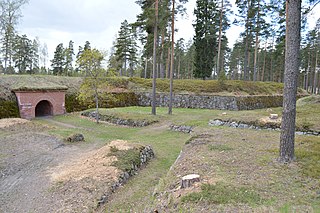
Taavetti Fortress, is a fortress located in Taavetti in the municipality of Luumäki in Finland.
{{cite news}}: Missing or empty |title= (help)